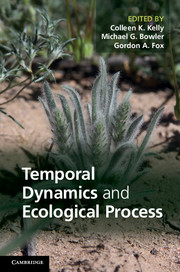Book contents
- Frontmatter
- Contents
- List of Contributors
- 1 Introduction
- Part I Observing temporal processes in nature
- 2 The storage effect: definition and tests in two plant communities
- 3 What temporal processes in trees tell us about competition, community structure and speciation
- 4 Testing the storage effect with long-term observational data
- 5 Seedling herbivory and the temporal niche
- 6 Temporal variation in density dependence in an herbaceous community
- 7 Population and community dynamics in variable environments: the desert annual system
- 8 Temporal niches, ecosystem function and climate change
- Part II Application to specific questions
- Index
- References
7 - Population and community dynamics in variable environments: the desert annual system
Published online by Cambridge University Press: 18 December 2013
- Frontmatter
- Contents
- List of Contributors
- 1 Introduction
- Part I Observing temporal processes in nature
- 2 The storage effect: definition and tests in two plant communities
- 3 What temporal processes in trees tell us about competition, community structure and speciation
- 4 Testing the storage effect with long-term observational data
- 5 Seedling herbivory and the temporal niche
- 6 Temporal variation in density dependence in an herbaceous community
- 7 Population and community dynamics in variable environments: the desert annual system
- 8 Temporal niches, ecosystem function and climate change
- Part II Application to specific questions
- Index
- References
Summary
Introduction
Desert annual plants are frequently used to illustrate the principles of adaptation to variable environments, the population dynamic functions of dispersal and dormancy, and how temporal variation may promote species coexistence (Cohen 1966, Venable and Lawlor 1980, Shmida and Ellner 1984, Chesson and Huntly 1988, 1989, Philippi and Seger 1989, Venable et al. 1993, Chesson 2000). All of these topics involve ecological and evolutionary responses to environmental variability. High levels of environmental variation driven by rainfall are a signature characteristic of hot deserts (Frank and Inouye 1994, Davidowitz 2002). Desert annuals have provided useful conceptual models because they have very simple life cycles and respond on a rapid time scale to such environmental variation (Patten 1975, Venable and Pake 1999, Venable 2007). ‘Good wildflower years’, when showy-flowered annuals blanket the desert, often occur in association with abrupt desert annual population increases. Such years are correlated with greater than average germination season rainfall and global climatic cycles, such as El Niño and Pacific Decadal Oscillations, in the case of US southwestern deserts (Cayan et al. 1999, Venable and Pake 1999, Bowers 2005). Desert annuals spend most of their lives as seeds and may even go unnoticed during their normal flowering season in years of little germination or high mortality. Persistent seedbanks play an important role in population and community dynamics, and it is not uncommon for species to reappear following years of absence.
While desert annuals are small and short lived, they occur as members of mature, persistent communities. This means that it is relatively easy to monitor multiple generations during the course of a single long-term project. Thus, in addition to being good conceptual models, desert annuals make good empirical models for exploring ecological and evolutionary dynamics in variable environments. Here, we present the results of our work combining the collection of long-term population dynamic data with several short-term focused approaches to understanding the ecology of Sonoran Desert winter annuals. We begin by introducing our study system and long-term data set, demonstrating how our data provide evidence for bet hedging and coexistence via the storage effect. Next, we describe a fundamental functional tradeoff that structures the dominant members of our community and determines the degree of interannual variation in fecundity. Finally, we explain long-term trends in response to climate change.
- Type
- Chapter
- Information
- Temporal Dynamics and Ecological Process , pp. 140 - 164Publisher: Cambridge University PressPrint publication year: 2014
References
- 5
- Cited by

